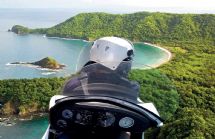Coco Island National Park, North Puntarenas
When visiting Coco's Island National Park, Costa Rica, both suburbanites and urban city dwellers are going to be amazed by the adventure that awaits. Tropical animals and exotic avian and marine life are just a few of the attractions that magnetize travelers visiting this beautiful island. The massive variety of wildlife is extremely attractive to visitors seeking eco-tourism discovery and excursions. Positioned 370 miles from Puntarenas, this island jewel off of Costa Rica’s Pacific coast is a unique world of its own, set apart even from other parts of Costa Rica. This seclusion magnifies the feeling that this remote (but accessible) island is an unusually delightful getaway, and a once-in-a-lifetime opportunity.
Ecological Framework
The Costa Rican government has worked tirelessly to protect plants and animals in the national park, despite being faced with financial shortfalls and other challenges. While pigs, rats, and goats have threatened some of these exotic species, the local authorities have been fighting a fierce and uphill battle to continue to protect indigenous wildlife. This area has enormous biological significance to the country, due to the large quantity of varying species that are residents of the island. By extension, this island has biological significance to the world at large. Ecologists and biologists from around the world have chosen Coco’s Island National Park to explore nature’s inner workings.
Rare Finds
A trek through the national park will likely expose tourists to many kinds of wildlife that are not common on the average city street. In fact, the area is teeming with animals that are so rare, they cannot be located anywhere else on the planet. In the nearby water, 270 kinds of fish are abundant, and a snorkeling adventure provides an intimate view of their variety. These exceptional finds are conventional discoveries in Coco’s Island National Park fauna. The phenomenal flora is exhibited by the 235 breeds of plants that punctuate the island’s versatile landscape.
Lay of the Land
Volcanic transformation has carved cliffs and valleys into the island landscape, creating a spectacular panorama. The absence of colonization has helped to preserve the island’s stunning and pristine composition. This lack of human settlement means that there are no hotels, hostels, or cabins for overnight stays on the island. This also means that island views are not obstructed by high-rise, mega-chain establishments. The intent is for Coco’s Island to remain a preserved sanctuary for wildlife and maintain an unsullied view for travelers in search of nature’s secrets.
Daytime Exploration
The island is accessible exclusively by boat, and the scenic journey to the point of destination nearly rivals the sights to be seen upon arrival. Tourists wishing to visit the island are welcome to take day trips to explore. Travelers may wish to discover the mysteries of the sea with a scuba diving excursion. These adventurous tourists can explore awe-inspiring underwater caves. In Coco’s Island, Costa Rica, snorkeling is a favorite pastime. Tourists can view the wonders of the sea while floating above the local marine life, if comfort does not allow for the ultimate scuba diving submersion.
Map of the Area

More Than Flora and Fauna
This exotic den of plants and animals has often been compared to the Galapagos Islands, its distant southern neighbor. Separated by more than 700 kilometers, they share many common traits, including rare birds, animals, and a beautifully feral ambiance. Going a step beyond the plant and animal scene, tourists will find magnificent waterfalls around the national park.
Coco’s Island is a photographer’s dream. It seems that the island is always camera-ready, in every direction. From towering cliffs to subterranean caverns, Coco’s Island is a world away from the everyday urban environment, and a great escape for travelers from any region.
10 Days / 9 Nights
Starting at $1,440 per person
6 Days / 5 Nights
Starting at $1,018 per person


















.jpg)



